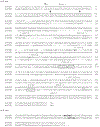Redefinition of the human kappa opioid receptor gene (OPRK1) structure and association of haplotypes with opiate addiction
- PMID: 15608558
- PMCID: PMC6141019
- DOI: 10.1097/00008571-200412000-00002
Redefinition of the human kappa opioid receptor gene (OPRK1) structure and association of haplotypes with opiate addiction
Abstract
The kappa opioid receptor (KOR) plays a role in stress responsivity, opiate withdrawal and responses to cocaine. KOR activation by its endogenous ligand dynorphin A(1-17) decreases basal and drug-induced striatal levels of dopamine. The complete structure of the human KOR gene (hOPRK1) has not been previously determined. This study: (i) characterized the genomic structure of the hOPRK1 gene; (ii) identified single nucleotide polymorphisms (SNPs) in the hOPRK1 gene; and (iii) investigated possible associations of these variants with vulnerability to develop heroin addiction. Analysis of 5'-RACE cDNA clones revealed the presence of a novel exon 1 ranging in length from 167 to 251 nucleotides in the 5' 5'-untranslated region of the hOPRK1 mRNA. We found that the hOPRK1 gene has four major exons and three introns, similar to rodent OPRK1 genes. Direct sequencing of amplified DNA containing all four exons and intron 1 of the hOPRK1 gene were evaluated for polymorphisms in 291 subjects (145 former heroin addicts and 146 controls). Twelve SNPs were identified, nine novel variants and three previously reported SNPs. Using logistic regression with opioid dependence as the dependent variable, the 36G>T SNP exhibited a point-wise significant association (P = 0.016) with disease status. The number of haplotypes seen in the three ethnic groups were nine, six and five for African-Americans, Caucasians, and Hispanics, respectively, with corresponding significance levels for differences in haplotype frequencies between cases and controls of P = 0.0742, 0.1015 and 0.0041. Combining ethnicities by Fisher's method yields an empirical significance level of P = 0.0020.
Figures


Similar articles
-
Analyses of polymorphisms of intron 2 of OPRK1 (kappa-opioid receptor gene) in association with opioid and cocaine dependence diagnoses in an African-American population.Neurosci Lett. 2022 Jan 18;768:136364. doi: 10.1016/j.neulet.2021.136364. Epub 2021 Nov 26. Neurosci Lett. 2022. PMID: 34843875
-
Human kappa opioid receptor gene (OPRK1) polymorphism is associated with opiate addiction.Am J Med Genet B Neuropsychiatr Genet. 2007 Sep 5;144B(6):771-5. doi: 10.1002/ajmg.b.30510. Am J Med Genet B Neuropsychiatr Genet. 2007. PMID: 17373729
-
Haplotypes at the OPRM1 locus are associated with susceptibility to substance dependence in European-Americans.Am J Med Genet B Neuropsychiatr Genet. 2003 Jul 1;120B(1):97-108. doi: 10.1002/ajmg.b.20034. Am J Med Genet B Neuropsychiatr Genet. 2003. PMID: 12815747
-
Search for genetic markers and functional variants involved in the development of opiate and cocaine addiction and treatment.Ann N Y Acad Sci. 2010 Feb;1187:184-207. doi: 10.1111/j.1749-6632.2009.05275.x. Ann N Y Acad Sci. 2010. PMID: 20201854 Free PMC article. Review.
-
Pharmacogenetics and human molecular genetics of opiate and cocaine addictions and their treatments.Pharmacol Rev. 2005 Mar;57(1):1-26. doi: 10.1124/pr.57.1.1. Pharmacol Rev. 2005. PMID: 15734726 Review.
Cited by
-
κ-opioid receptor/dynorphin system: genetic and pharmacotherapeutic implications for addiction.Trends Neurosci. 2012 Oct;35(10):587-96. doi: 10.1016/j.tins.2012.05.005. Epub 2012 Jun 16. Trends Neurosci. 2012. PMID: 22709632 Free PMC article. Review.
-
Polymorphisms of the kappa opioid receptor and prodynorphin genes: HIV risk and HIV natural history.J Acquir Immune Defic Syndr. 2013 May 1;63(1):17-26. doi: 10.1097/QAI.0b013e318285cd0c. J Acquir Immune Defic Syndr. 2013. PMID: 23392455 Free PMC article.
-
An overview of the genetics of substance use disorders.Curr Psychiatry Rep. 2006 Apr;8(2):133-43. doi: 10.1007/s11920-006-0013-3. Curr Psychiatry Rep. 2006. PMID: 16539891 Review.
-
The OPRD1 and OPRK1 loci in alcohol or drug dependence: OPRD1 variation modulates substance dependence risk.Mol Psychiatry. 2008 May;13(5):531-43. doi: 10.1038/sj.mp.4002035. Epub 2007 Jul 10. Mol Psychiatry. 2008. PMID: 17622222 Free PMC article.
-
Antidepressant-like effects of buprenorphine in rats are strain dependent.Behav Brain Res. 2015 Feb 1;278:385-92. doi: 10.1016/j.bbr.2014.10.014. Epub 2014 Oct 18. Behav Brain Res. 2015. PMID: 25453747 Free PMC article.
References
-
- Kreek MJ. Opiates, opioids and addiction. Mol Psychiatry 1996; 1:232–254. - PubMed
-
- Kreek MJ. Opioid receptors: some perspectives from early studies of their role in normal physiology, stress responsivity and in specific addictive diseases. J Neurochem Res 1996; 21:1469–1488. - PubMed
-
- LaForge KS, Yuferov V, Kreek MJ. Opioid receptor and peptide gene polymorphisms: potential implications for addictions. Eur J Pharmacol 2000; 410:249–268. - PubMed
-
- Mayer P, Höllt V. Allelic and somatic variations in the endogenous opioid system in humans. Pharmacol Ther 2001; 91:167–177. - PubMed
-
- Kreek MJ. Opioid and cocaine addictions: challenge for pharmacothera-pies. Pharm Biochem Behav 1997; 57:551–569. - PubMed
Publication types
MeSH terms
Substances
Grants and funding
LinkOut - more resources
Full Text Sources
Medical
Molecular Biology Databases

